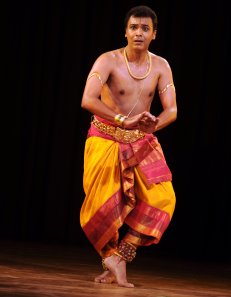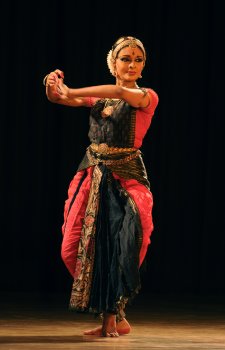
|   |

|   |
Madras Music Academy dance festival: Day 4 - Veejay Sai e-mail: vs.veejaysai@gmail.com Photos courtesy: Madras Music Academy January 16, 2013 Reverse gear craft  The fourth day morning opened with a fairly packed hall. Anwesha Das, a student of Urmila Sathyanarayanan, was to dance with her guru supporting her on the nattuvangam, according to the Music Academy’s announcement. Sai Kripa had replaced Urmila who was nowhere to be seen on stage till the first Alarippu finished. Post that, Urmila emerged with a mic in her hands and played the role of the announcer for the rest of the show. Anwesha presented ‘Manavi Chekonarada,’ a classic varnam in ragam Shankarabharanam composed by Ponniah Pillai of the Thanjavur quartet. Of late, announcers just say “a composition of the Thanjavur/Tanjore quartet” and leave it open-ended making it look odd. It feels as if the four brothers sat down in some kind of a jam session and did a garage gig. What is wrong in doing a little homework and announcing which of the four composed a particular number? At some point, the nayika wanted to send messages to the lord via the clouds, tamed deer and whatever else. There was a disconnect between what was being sung and what was being interpreted. The very word ‘mamata’ has layers of meaning and interpretation. While Anwesha was good in her nritta with clear lines, the problems with her nayika seemed two-fold. She began sancharis abruptly and wouldn’t allow a single idea to grow into its fullness, the other being the awkward choreography that kept taking her in a backward strut, endless times through the course of the varnam. Even in the Anu Pallavi, where the singer kept singing ‘Brighadeeshwara’ instead of ‘Vinara sri Thanjapurilo velayu maa Brihadishwara,’ Anwesha kept moving on the reverse. With so much of backward movement, why would Lord Brihadishwara keep chasing her, in spite of her calling so many times? The energy in the varnam came from the vocal support provided by Swamimalai S K Suresh and violinist Kalaiarasan who rendered their respective music exceptionally. She continued into a padam in ragam Begada by Vaitheeshwaran Koil Subbarama Iyer, a Surdas bhajan and a Thillana by Dr. Mangalampalli Balamurali Krishna. Once again Anwesha had one too many things crammed in her effort to narrate all the various leelas of Lord Krishna. Anwesha is a good dancer with a lot of promise and talent. If she can present herself with better choreographed works and polish her abhinaya, she can be looked up to as yet another promising youngster to look out for in the dance scene. Lone nayaka among nayikas  Last year, the Music Academy had at least a few male dancers presenting solo works. This year, due to some strange cultural recession, they had only one male soloist in the mid-morning slot. And that honour went to Mumbai based Vaibhav Arekar. Opening with a ‘Surya Stuti,’ Vaibhav’s presentation was crisp to the point without unnecessary meandering. What struck one right from the very beginning was the young nattunavanar Kalishwaran Pillai’s efficient delivery of jatis. Being the son of the great T S Kadirvelu Pillai, one could see how the baton of the Thanjavur tradition had been successfully passed down to the next generation. Premised on hasya rasa, Vaibhav’s next piece was a combination of two Subhashitas. Choreographed by his guru Kanak Rele, the authorship of these poems remains unknown. Set to ragam Mohanam, the first one was a dialogue between Ganesha and his brother Karthikeya. Teasing each other, the brothers come under the watchful eye of their mother Parvati. The second one in ragam Reetigowla was the story of Vishnu’s unannounced visit to Shiva in a digambara avastha. Shiva decides to dress up for the occasion with his usual animal-skin garments but is left embarrassed as the snake that belts his coverings slips away after being threatened by Garuda, Vishnu’s vehicle. Vaibhav’s abhinaya to the actions of the eagle and snake were delightful. For all those who were tired watching enough of bhakti and shringaaram this season, Vaibhav’s novelty was much appreciated. While both these Subhashitas were excellent as independent poems, they could have been strung together in some sort of narrative within the choreography. A neatly choreographed Swati Thirunal kriti on Hanuman ‘Anjaneya Raghurama doota’ took the shape of a varnam. Portraying various popular tales from mythology on Hanuman in his sancharis, Vaibhav presented what one wouldn’t generally think of as a varnam. There was a bit of jumping around in both this and the earlier piece, but the sequences demanded it. While Arun Gopinath has grown to be an outstanding singer for dance in the last few years, a little effort to get his pronunciation of sahityam would help improve the quality of presentations. At one point in the varnam on Hanuman, he kept unconsciously singing ‘Langa’ instead of ‘Lanka’ in a sequence. Why don’t singers consult scholars to correct their diction? It doesn’t take much to do it. Vaibhav continued his performance into a piece titled ‘Mukti’. Utilizing a simple yet elegant ragam- tanam technique, this pure dance piece was set to ragam Todi. Narrating the tale of the devoted Nandanar struggling to get a glimpse of Lord Shiva while an adamant Nandi obstructed his view, Vaibhav’s dance reached a point of high drama, all in a rectangular frame of light thrown as an open temple door at the far end of the stage. It is important to have a good light designer who also understands the process of good art and participates enthusiastically. Sushant Jadhav’s expertise stood out exemplary in his perfect sense of timing in this particular item. However the final Thillana in Shivaranjani, seemed a bit misplaced with the pathos in the mood of the ragam standing in forefront after such an energetic performance. Vaibhav’s show reiterated the fact that significantly promising and committed male dancers, if given a good opportunity, will prove their worth. All those with second thoughts on male dancers have to eat their words for artistes like Vaibhav Arekar, who is easily one of the pre-eminent male soloists on the Bharatanatyam scene today. Between the ripping and the clipping  In the last few years if there has been one face that has spread itself thin across global audiences in the world of Bharatanatyam, it is Priyadarsini Govind. With innumerable DVD’s invading every nook and corner, Priya’s is an image that grew from strength to strength, almost to become the global face of the dance form itself. This phenomenal growth, however, seemed to reflect in a decline in her own dance presentations. Opening Academy’s festival last year, we all saw how her jewelry fell all across the stage. This year things went from bad to worse. While wardrobe malfunctions happen time and again to artistes, this particular case needs to be looked at carefully, given the high-seat of esteem Priya Govind holds in the world of dance. Such fame doesn’t come without responsibility, leave alone the utter scrutiny of each and every minute detail being presented on stage. Two minutes after she began her opening piece ‘Saravana Bhava’, an Alarippu, the fan of her bright costume ripped off on one side revealing the ugly black Velcro tape beneath. Dance is a visual medium and fortunately or unfortunately what one sees leaves a strong imprint on the mind. For a hall full of rasikas who turned up for Priya’s show, this was outright embarrassing, more so as she decided to ignore the mishap and continue dancing. Was she taking her audiences for granted? Or the festival and the stage? Though the dance was good, the damage done to the viewers was beyond repair. An embarrassed Priya left the stage and quickly emerged in the second item she presented, this time with the fan shoddily pinned up to her costume. The classic Husseini Swarajathi ‘Ye mayaladi ra’ was presented at the most with a superficial glare, bereft of emotion. Nowhere in the Swarajathi did Priya take any effort to establish the lovelorn nayika. Added to this were extra-long designer jathis written by G Vijayaraghavan that ruined the mood of the composition. This same item was performed with far more interest by A Lakshman on the same stage last year. Why can’t dancers stick to traditional jathis? What’s with the new trend to take up these newly composed jathis? Most of them sound fine for the mridangam but to watch one jathi go on and on is exasperating even to the keenest of audiences. The third piece she presented was a popular Ninda stuti composed by Papavinasa Mudaliar in ragam Khamboji. The mood of the theme was of a bhakta teasing Lord Nataraja as to why he lifted one leg of his. While Priya seemed a bit more composed with her noteworthy abhinaya, “Hope she doesn’t rip her fan off lifting her leg so many times!” exclaimed a rasika. Another mishap would have been a bit too much to handle for the veteran rasikas in the hall. The show continued into the famous Dharmapuri Subbaraya Ayyar’s javali ‘Smarasundaranguni’ before a Thillana. Priya ended her show with the popular Dikshitar’s Nottuswaram ‘Vande Meenakshi,’ which seemed outright redundant and at the most a sign of playing up to the galleries. Having trained with such fine gurus, holding such an exalted status in the world of dance, why do Priya’s shows go awry, especially at the Music Academy and in the Margazhi season? Priya is undoubtedly a good dancer and her latest Central Sangeet Natak Akademi Award was in news all over getting more rasikas to flock to her show. Hopefully she will put up a better show another time. Trials and tribulations in perceptions  The final performance for the evening was a group presentation by the Jawaharlal Nehru Manipur Dance Academy from Delhi. The Manipuri academy opened with a presentation titled ‘Shraddhanjali’ with long sequences choreographed on India’s freedom struggle, national movement and more. From songs on Gandhi and Tagore to slogans and flag-waving, over a dozen dancers performed a high-energy rendering for an opening. However this whole affair became too long for any invocatory piece. They announced a fifteen minute interval between this and the main piece and that had half the hall making a silent exit. Most of the others who sat through the rest of the show, sat out of sheer courtesy. Keibul Lamjao is the floating sanctuary around the Loktak Lake and is home to the famous Sangai deer. Once upon a time these were the most famous wildlife one could notice in that part of the country. Ecological disasters and human greed reflected in the gradual decline in the deer population. The current production dealt with the various folk tales about these antlers and how they were killed for selfish reasons, how several conservationists propagated activism to rescue the deer population and succeeded in making the killing of these species an illegal one, by an act of regulation. A few of the folk and ritual dance sequences and original music score was the saving grace for the show. While the story in itself was interesting and so was the noble cause behind it, the production turned out to be long and slow under the direction of Chaotombi Singh. In addition to this, was the language problem of what was being communicated to the audiences. The Manipur dance academy has presented some of the finest choreographic productions earlier; however this was not one of their best. It is surely important for the rest of India to know the history, arts and culture in the North East and take equal ownership of it like anywhere else. For that, prestigious academies must ensure their production qualities remain high and worthy enough for consumption by one and all. Veejay Sai is a writer, editor and a culture critic. |